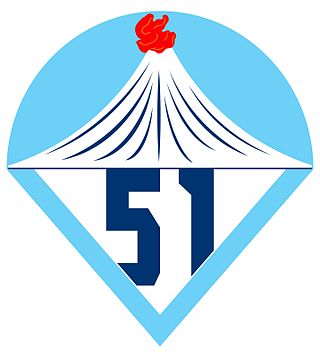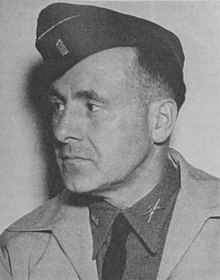
The 51st Infantry Division was a division of the Philippine Army under the United States Army Forces in the Far East (USAFFE).

The 11th Infantry Division was one the reserve division of the Philippine Army that was mobilized in September 1941 under the United States Army Forces in the Far East (USAFFE).

The 71st Infantry Division was a reserve division of the Philippine Army that fought under the United States Army Forces in the Far East (USAFFE). It was known for its fight with Japanese invading forces in Layac Junction, that was ordered to hold until all retreating Fil-American forces of crossed into Bataan Peninsula.

The 81st Infantry Division was a reserve division of the Philippine Army under the United States Army Forces in the Far East (USAFFE). It was established in the prewar period and fought 1941–1942. Its troops are from Cebu, Bohol, and Leyte but most of its troops are Americans and junior officers are Filipinos coming mostly from Luzon. The division served in defense of Mindanao but it never commanded the 4 of its maneuver regiments but was supplemented with 61st Infantry from Panay and 73rd Infantry from Negros. Also, 2nd Regular Regiment was transferred to its command in the early part of Japanese invasion of Mindanao.

The 101st Infantry Division was one the reserve divisions of the Philippine Army under the United States Army Forces in the Far East (USAFFE)'s 10th Military district mainly entire island of Mindanao.
The 102nd Infantry Division was a division of the Philippine Army under the United States Army Forces in the Far East (USAFFE).

The 91st Infantry Division was a division of the Philippine Army under the United States Army Forces in the Far East (USAFFE).
Visayas-Mindanao Force was a military formation created in November 1941 to command all soldiers of US Army, US Philippine Scouts, Philippine Army, and Philippine Constabulary in the southern islands of the Philippines. Colonel William F. Sharp was appointed as commanding general and was promoted to Brigadier General in November 1941 and later Major General. His executive officer is Major Howard Edmands. He was just starting to organize his command and train his soldiers into a fighting unit when the war started on December 7, 1941.

Mindanao Force is a corps size military unit defending the island of Mindanao the second largest Island of the Philippines from March 17, 1942, to its surrender on May 9, 1942. The force was already created when the Visayas-Mindanao Force was split into two in March 1942. It was initiated in February 1942 in the headquarters of US Army Forces in the Far East but took effect when General Douglas MacArthur departed for Australia on March 17, 1942.
61st Infantry Regiment is a military unit and formation of the Philippine Commonwealth Army, activated in August 1941 in Panay Island. It is under the command of 61st Infantry Division of the Philippine Commonwealth Army. The regiment collapsed in May 1942 with its commanding officer captured by the Japanese Army in Lanao.

Visayan Force is a US Forces in the Philippines subcommand which was created and took effect on March 17, 1942, after General Douglas MacArthur departed for Australia. It was disintegrated in the month after its creation due to the loss of contact of Visayan Force headquarters during the Japanese invasion of Cebu in April 16 to 19, 1942, it resorted to guerilla warfare. Eventually all forces in the Visayas was ordered to surrender on May 11, 1942.
82nd Infantry Regiment is a unit activated by the Philippine Commonwealth Army for the defense of the Philippine during World War II. It defended the Cebu Island particularly in the southern part of Cebu during the Japanese landings in Cebu island on April 16, 1942. It surrendered on May 12, 1942, after it was ordered by Visayas-Mindanao Force commander General Sharp to surrender.
Cebu Brigade is a military unit and formation organized in January 1942 by Visayas-Mindanao Force to defend the island of Cebu after ordering 81st Infantry Division Headquarters moved to Mindanao to bolster its defenses. USAFFE and later USFIP saw the island vital for the transport of the supplies to Bataan and Corregidor. Colonel Irvine Scudder was appointed as its commander until its surrender to Japanese.
Negros Force was activated by USAFFE on September 1, 1941, to May 12, 1942. The force did not fought during the war but played in organizing units deployed to different sector. The force also continued to fight as a guerilla after the surrender. Although the two provinces was never united due to different affiliation of the commanders.
62nd Infantry Regiment was Philippine Army Reserve unit activated in November 1941 in Panay Island. It was organized from the Army reservist in that area with officers mostly coming from Luzon and Americans. I was based and trained in Cabatuan, Iloilo and was placed as part of 61st Infantry Division activated on November 1, 1941, in preparation for Japanese invasion of the Philippines.
63rd Infantry Regiment is a reserve unit of Philippine Army activated and organized during World War II. I was organized from reservist and recruits high school and college students around the 6th Military District. It is part of the 61st Infantry Division activated to cover the island of Panay. The regiment fought entirely in Panay island until it was ordered to surrendered on May 12, 1942.
United States Forces in the Philippines (USFIP) is a unified command in the Philippines during World War II. It was the successor to the United States Army Forces in the Far East (USAFFE) which General Douglas MacArthur commanded. He moved to Australia as he evacuated as ordered by President Roosevelt in March 1942. The command only lasted two months as it surrendered by Lieutenant General Jonathan M. Wainwright to Lieutenant General Homma Masaharu commander of 14th Army of the Imperial Japanese Army.
On April 14, 1942 Kawaguchi Detachment who just landed in Lingayen, Pangasinan intended as reinforcement of the 14th Imperial Japanese Army to finally subdue Philippine-American forces in Bataan. However, General King surrendered days earlier before they arrived. Instead, General Homma Masaharu commander of 14th Army ordered them south to secure Cebu island in the Visayas intended as launching place for invasion of Mindanao after it is secured.
Japanese invasion of Panay on April 16–18, 1942 was the second landing in the Visayas Islands after Fil-American forces surrendered in Bataan on April 9, 1942. It is the next step to prevent any supplies reach Corregidor Island and control the Visayas waters and established bases for the campaign to invade island of Mindanao to complete the invasion of the Philippines.
61st Field Artillery Regiment is a reserve unit of Philippine Army activated in August 1941 as part of 61st Infantry Division based in Panay Island. It fought as infantry as their guns did not reached them as it was sunk when SS Corregidor hit landmine in Manila Bay.









